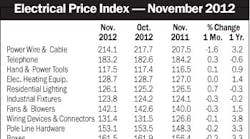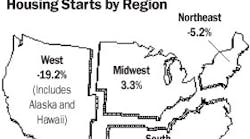Latest from Mag
While it’s not recession-proof, the local economy in Omaha, Neb., never hits the unsustainable highs or dramatic lows common in some fast-track regions of the United States. “I think our territory will probably make it through this recession or economic slowdown, whatever we want to call it, because of agribusiness,” said Larry Keating, principal, Electrical Products Co., Omaha. “But you have to footnote that if you are selling to the residential market. That market is off significantly. We’re no different from anyplace else in the country with one exception — our highs are not quite as high, our lows are not quite as low.”
Omaha is the largest city in the state of Nebraska and has a population of 427,872. Located in eastern Nebraska on the banks of the Missouri River, the city is a three-hour drive north of Kansas City, Mo. According to one electrical distributor who talked to Electrical Wholesaling but asked not to be identified, Omaha and its neighbor across the Missouri River, Council Bluffs, Iowa, operate as one metropolitan area. Reps and distributors covering the Omaha territory get a traditional mix of commercial, industrial, utility and residential business from these cities, and agriculture-related business from food processing plants, ethanol facilities, and large commercial farms from the farmlands surrounding the Omaha-Council Bluffs area, which has more than 800,000 total residents. The construction of wind farms in Iowa is increasing and is providing at least one rep in the territory with a new flow of orders for connectors, splicing equipment and other mainstream electrical products.
Omaha doesn’t often make the national news, with the notable exceptions of the annual meeting for stockholders of Berkshire Hathaway held by Warren Buffett, the area’s most famous resident, and the annual College Baseball World Series. Any visitor to Omaha will be struck by the amount of new riverfront development in downtown Omaha, and the commercial and retail development in Council Bluffs. In downtown Omaha, the Old Market area is alive with loft renovations, new restaurants and retail shops, and residents are excited about the new baseball stadium to be built on the riverfront. Union Pacific railroad has a new headquarters downtown. A massive redevelopment project just north of downtown includes the new Qwest Center, a state-of-the-art sports arena; a Hilton Hotel; offices; multi-family housing; and a pedestrian/bicycle bridge across the Missouri River that will soon link Omaha to miles of trails in Iowa.
Five Fortune 500 companies are headquartered in the greater Omaha area, including Berkshire Hathaway; Union Pacific Corp., the largest railroad in North America with operations in 23 states; ConAgra Foods, an international diversified food giant; and Peter Kiewit Sons’ Inc., one of the nation’s largest general contractors; and Mutual of Omaha Companies.
One of the biggest projects on the drawing boards is the construction of the new NCAA College World Series (CWS) baseball stadium. Under a new contract, the NCAA agreed to keep the CWS in Omaha for 25 years. The series will remain at Rosenblatt Stadium through 2010, then will be played at a new 24,000-seat downtown stadium from 2011 through at least 2035. “That’s been big news for us,” said one distributor. “That’s going to spur some nice commercial development along the riverfront.” In place of the current Rosenblatt Stadium, officials are looking at expansion plans for the Henry Doorly Zoo. Several miles away in Omaha’s downtown, several mixed-use projects are in the works. including Midtown Crossing and central Omaha’s Aksarben Village.
Most of Omaha’s expansion has been in the west area of the city, said Don Perry, president of Perry & Associates Inc., a manufacturers’ rep in Ralston, Neb., who started in the agency business in 1975 and started Perry & Associates with another rep in 1979.
One notable upcoming project in the Omaha-Council Bluffs area is a proposed Google facility. Google purchased 1,000 acres south of Council Bluffs for a $600 million data center that’s expected to employ 200 people and open in 2009. Ken Patchett, a Google executive, told The Associated Press that Council Bluffs’ fiber-optic network makes the Omaha-Council Bluffs area an important nexus for telecommunications and military transmissions.
Ethanol is also driving the Omaha economy. According to www.drivingethanol.org, ethanol is a clean-burning, high-octane fuel that is produced domestically from renewable sources such as corn and other crops. Ethanol is big business in the Midwest because of the amount of available raw material, specifically corn. Ethanol construction continues with two of Nebraska’s largest ethanol plants being built this year, said Bill Devereaux, Jr., president R/B Sales Corp., Marion, Iowa. One of these plants (200 million gallons) will be located outside Aurora, Neb., and will be owned by Aventine
Renewable Energy. Many other new plants are being considered, but rising construction and transportation costs, along with record corn prices, have stalled many of the proposed projects before they can get off of the ground, said Devereaux. Another big proposed ethanol project is the Southwest Iowa Renewable Energy (SIRE) plant outside Council Bluffs.
Another example of a new energy source is wind farms. There are at least four wind-farm projects being built this year in Iowa and four potential sites are being considered in Nebraska for 2008, said Devereaux. R/B Sales has sold electrical products to wind farms since the inception of the wind energy business in Iowa, but the first major project he remembers was in 1999 when he sold truckloads of DLO (diesel locomotive cable) to the customer. “It’s what first helped me to understand the magnitude of the wind turbines; both in raw size and as an asset to the electrical community,” he said.
R/B Sales sells a variety of products for wind generation: DLO cable, medium-voltage terminations, bare copper products, cable preparation products, and unit heaters among other items. The Wind Farm Projects are Top of Iowa III, Pomeroy II, Charles City and Pomeroy I.
“So much varies from site-to-site with different designs and different people. It’s a matter of providing the right part for the customer’s application,” he said.
Herm Isenstein, president, DISC Corp., Orange, Conn., estimates that electrical distributors in the Omaha metropolitan area sold approximately $181 million in electrical products in 2007. A fractional decrease in sales is expected in 2008.
The one distributor who talked anonymously to EM says he hopes the economy will be good for the rest of the year. “The manufacturing portion of the business doesn’t seem like it’s backing off any,” he said. “The agriculture part of the business seems to be fairly strong. Farmers have high crop prices, so they have some money to spend. That trickles right down the line to us. Also in our rural areas outside of the metro areas, we get involved in grain storage.”
Joe Bertsch Jr., principal, Joe Bertsch Electrical Sales Co., Cedar Rapids, Iowa, said the residential business is extremely soft in most markets, but commercial is going well and industrial is modest. “Omaha is a commercial area, obviously, with a lot of Fortune 500 companies and with a couple of the newer facilities that are going up.” Bertsch says from an industrial standpoint, ethanol is helping to sustain his company. He is optimistic with regard to the commercial and industrial business in the Omaha area and is looking at double-digit growth with the lines he carries.

